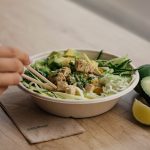Tale as Old as Tea
Teas go waaaaaay back. Tea has been a popular beverage around the world in every social class, from nomads in the Sahara to royalty in Great Britain.
Legend has it that tea was born in China when a Chinese Emperor, sitting beneath a tree, drank some boiled water with leaves that had fallen into it. And it just so happened that he enjoyed this new beverage. Tea became the national beverage of China and was later introduced into Japan by Buddhist monks, where the tea ceremony was developed.
By the time it was introduced into Great Britain, the Chinese and Japanese had been brewing teas for a long time. Tax laws in Great Britain made tea expensive, which resulted in smuggling and faux teas (just like faux Gucci!). And just like an underground drug smuggler, criminals illegally imported millions of pounds of tea into the country. Since there was no quality control, many times the tea was adulterated with non-tea substances. Would you like a spot of tea with a spot of dirt and twig?
Tea was not simply a beverage to drink. It drove trade, taxation, and even crime. Tea became a part of every day life as tea ceremonies and social norms were formed around the act of tea drinking. Today, you can still find high tea parlors that mimic the way tea was enjoyed in British society, just in case you want to practice your pinky-up technique.
The Health Benefits of Tea
Tea is used by many holistic practitioners and ancient medicine healers to promote health and vitality, but also as a way to alleviate many ailments. Herbs can be powerful healers, and tea gives us a way to sip our medicine to bathe our insides in the healing properties of herbs. Tea also offers a safer option for supporting health over drugs, medications, and alcohol (an herbal nightcap will do much more for sleep than an alcoholic one will). There can be interactions between herbs and supplements and there are certain herbs that can cause adverse side effects in people (and especially pregnant/lactating women), but for the most part, they offer their benefits in a gentle way.
Premium Tea vs. Low-Quality Tea
Just as there is an art to selecting and enjoying a fine wine, there are many fine teas to choose from, too. Tea connoisseurs prefer loose leaf over a pre-measured amount of “herb dust” stuffed into a plastic and glue-lined tea bag. Oh, sorry, was my tea snobbery showing a bit?
Not only does loose-leaf tea taste more flavorful, but it is cleaner for your body and better for the environment. For more information about what might be lurking in your tea bag, check out this post. You might be surprised.
There is a vast difference between green teas found in your local grocery store and premium green teas imported from China with a high price tag (just like the difference between boxed wine and an expensive bottle of aged wine). It can be quite an experience to drink a cup of high quality green tea, and for many, the high price tag is worth it for its freshness, flavor, and health benefits.
Decoctions and Infusions
In my opinion, decoctions are the best way to brew tea for medicinal purposes. Decocting helps pull out the beneficial properties of hard roots, seeds, bark and berries. Be forewarned though, the flavors of decoctions can be very strong!
Although it sounds like something from the world of wizards, anyone can make a decoction. Decoctions work best for extracting the properties of the woody parts of the plant, such as the bark and root. To make a decoction, place a few tablespoons of your herbs into a pot of cold water, bring it to a boil, then cover and reduce heat to simmer for 15 minutes to an hour. Remove from the heat, strain your herbs, and drink 1 cup or sip throughout the day. Refrigerate what you do not drink for up to two days. If you’d like to flavor your decoction with the more fragile parts of the herb (leaves, flowers, etc.), add these in when you remove the decoction from the heat and allow it to steep for 10 more minutes, then strain. See the recipe below to try your hand at decocting. Note: You don’t need a wand.
Infusions, on the other hand, are herbs placed into a water to infuse the water. We can make infusions by immersing herbs in hot water and steeping for 5-15 minutes, or we can make cold water infusions where herbs are steeped overnight in cold water. Cold infusions are best for slimy herbs such as marshmallow root.
Tea for Your Lady Parts
If you have never heard of vaginal steams or sitz baths before, this may seem a bit strange. Basically, you are exposing your lady parts to herbs to help with a variety of ailments such as painful menstruation, heavy bleeding, infertility, hemorrhoids, and healing from childbirth. It is said to work by enhancing circulation to the area to promote healing.
Vaginal steaming involves sitting over a pot of herbs in hot water (careful not to burn yourself!). To learn more and to buy your own steam blends, visit Women’s Health Coach Marina Schroeder’s site.
Sitz baths, on the other hand, involve bathing in an herbal brew to promote perineum healing after childbirth. Many midwives and doulas make their own blends or can point you in the direction of where to get some. I recommend Baby Nest Birth Services for herbal sitz bath forumlas.
Opt for Quality Teas
As always, I recommend spending a few extra bucks for quality. Even though the days of tea smuggling are long gone, many teas on the market contain ingredients you may not want to sip on, such as pesticides, arsenic, plastics (in the tea bags), natural flavors, and lead. Opt for organic, loose leaf tea for a healthier brew.
The Tea Ceremony
Beyond providing healing properties, brewing a cup of tea involves connecting with the herbs through our senses. It involves pouring hot water over them and inhaling the aroma, taking some time to sit down, slow down, and enjoy a healing elixir.
Some of my favorite healing elixirs include dandelion tea for liver health, sage tea for digestive health, spearmint tea for hormonal health, and catnip tea for easing occasional anxiety.
Medicinal Strength Tea Recipe
Medicinal strength tea is potent. It is made by decocting herbs and is the best method for extracting medicinal properties of roots, bark, and seeds. This tea contains adaptogens that can help buffer the effects of stress.
Ingredients:
- 1 tsp eleuthero root
- 1 tsp ashwagandha
- ¼ tsp ginger root
- ½ tsp orange peel
- ½ tsp chaga mushroom
- ½ tsp licorice root
Instructions:
- Bring ½ quart of cold water to a boil.
- Add ½ ounce of herbs.
- Reduce to simmer and cover for 20 minutes to an hour. Keep the heat as low as possible while simmering. Covering it will keep the herbs’ oils contained.
- After simmering, you can continue to let the herb steep overnight, or strain it. Drink ¼ cup of tea per day and refrigerate the rest.




